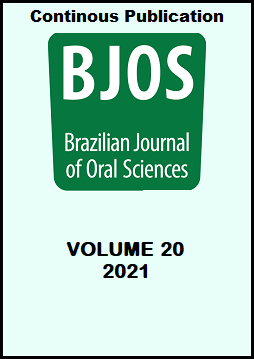Abstract
Aim: To propose a new method to determine in vitro potentially bioavailable fluoride (F) in diet and toothpaste after ingestion. Methods: Diet samples (D) were obtained from 15 portions of a meal served to children in a day care centre. To simulate the ingestion of toothpaste during brushing after meals, a specific amount of toothpaste was added to the diet samples (D + T). F was determined in D and D + T after incubation in a solution that simulated “gastric juice” (0.01 M hydrochloric acid) at 37oC for 30, 60 and 120 min. Microdiffusion facilitated by HMDS was used to determine the total F concentrations in samples D and D + T. The analyses were performed using an ion specific electrode. Results: For D samples, incubation in “gastric juice” for 30, 60 and 120 min resulted in F concentrations (μg F/mL) of 0.75 ± 0.06c, 0.77 ± 0.07c and 0.91 ± 0.09b, corresponding to 75.3, 77.3 and 90.7% of the total F (1.02 ± 0.12a), respectively (p = 0.0001; ANOVA + Tukey). For D + T samples, these values of F concentrations (μg F/mL) were 2.55 ± 0.46b, 2.83 ± 0.44ab and 3.15 ± 0.37a, corresponding to 86.9, 94.8 and 106.7% of the total F (2.99 ± 0.34a), respectively (p = 0.0023; ANOVA + Tukey). Conclusion: Then, it can be concluded that the proposed method of “gastric juice” is a promising protocol for determining potentially bioavailable fluoride in the diet and toothpaste after ingestion. However, additional studies are desirable.
References
- Guha-Chowdhury N, Drummond BK, Smillie AC. Total fluoride intake in children aged 3 to 4 years - a longitudinal study. J Dent Res. 1996 Jul;75(7):1451-7. doi: 10.1177/00220345960750070401.
- Rojas-Sanchez F, Kelly SA, Drake KM, Eckert GJ, Stookey GK, Dunipace AJ. Fluoride intake from foods, beverages and dentifrice by young children in communities with negligibly and optimally fluoridated water: a pilot study. Community Dent Oral Epidemiol. 1999 Aug;27(4):288-97. doi: 10.1111/j.1600-0528.1998.tb02023.x.
- Lima YBO, Cury JA. [Fluoride intake by children from water and dentifrice]. Rev Saude Publica. 2001;35(6):576-81. doi: 10.1590/S0034-89102001000600012. Portuguese.
- Paiva SM, Lima YBO, Cury JA. Fluoride intake by Brazilian children from two communities with fluoridated water. Comm Dent Oral Epidemiol. 2003 Jun;31(3):184-91. doi: 10.1034/j.1600-0528.2003.00035.x.
- Omena LMF, Silva MF, Pinheiro CC, Cavalcante JC, Sampaio FC. Fluoride intake from drinking water and dentifrice by children living in a tropical area of Brazil. J Appl Oral Sci. 2006 Oct;14(5):382-7. doi: 10.1590/s1678-77572006000500015.
- Lima CV, Cury JA, Vale GC, Lima MD, Moura LF, Moura MS. Total fluoride intake by children frmo a tropical Brazilian city. Caries Res. 2015;49(6):640-6. doi: 10.1159/000442029.
- Lima-Arsati YBO, Gomes ARLF, Santos HKA, Arsati F, Oliveira MC, Freitas VS. Exposure to fluoride of children during the critical age for dental fluorosis, in the semiarid region of Brazil. Cien Saude Colet. 2018 Apr;23(4):1045-1054. doi: 10.1590/1413-81232018234.07952016. Portuguese.
- Martins CC, Paiva SM, Lima-Arsati YBO, Ramos-Jorge ML, Cury JA. Prospective study of the association between fluoride intake and dental fluorosis in permanent teeth. Caries Res. 2008;42(2):125-33. doi: 10.1159/000119520.
- Warren JJ, Levy SM, Broffitt B, Cavanaugh JE, Kanellis MJ, Weber-Gasparoni K. Considerations on optimal fluoride intake using dental fluorosis and dental caries outcomes - a longitudinal study. J Public Health Dent. 2009;69(2):111-5. doi: 10.1111/j.1752-7325.2008.00108.x.
- Cury JA, Del Fiol FS, Tenuta LMA. Low-fluoride dentifrice and gastrointestinal fluoride absorption after meals. J Dent Res. 2005 Dec;84(12):1133-7. doi: 10.1177/154405910508401208.
- Falcão A, Tenuta LMA, Cury JA. Fluoride gastrointestinal absorption from Na2FPO3 /CaCO3 - and NaF/SiO2 – based toothpastes. Caries Res. 2013;47(3):226-33. doi: 10.1159/000346006.
– Martinez-Mier EA, Tenuta LMA, Carey CM, Cury JA, Van Loveren C, Ekstrand KR, et al. ORCA Fluoride in Toothpaste Analysis Work Group. European Organization for Caries Research Workshop: Methodology for Determination of Potentially Available Fluoride in Toothpastes. Caries Res. 2019;53(2):119-36. doi: 10.1159/000490196.
– Reshetnyak VY, Nesterova OV, Admakin OI, Dobrokhotov DA, Avertseva IN, Dostdar SA, et al. Evaluation of free and total fluoride concentration in mouthwashes via measurement with ion-selective electrode. BMC Oral Health. 2019 Nov 20;19(1):251. doi: 10.1186/s12903-019-0908-0.
- Taves DR. Separation of fluoride by rapid diffusion using hexamethyldisiloxane. Talanta. 1968 Sep;15(9):969-74. doi: 10.1016/0039-9140(68)80097-9.
- Martínez-Mier EA, Cury JA, Heilman JR, Katz BP, Levy SM, Li Y, et al. Development of gold standard ion-selective electrode-based methods for fluoride analysis. Caries Res. 2011;45(1):3-12. doi: 10.1159/000321657.
- Idowu OS, Azevedo LB, Valentine RA, Swan J, Vasantavada PV, Maguire A, et al. The use of urinary fluoride excretion to facilitate monitoring fluoride intake: a systematic scoping review. PLoS One. 2019 Sep;14(9):e0222260. doi: 10.1371/journal.pone.0222260.
- Fernandes LMAG, Cury JA. [Prenatal fluoride - metabolic evaluation]. RBM Rev Bras Med. 1993 Nov;50(11):1546-52. Portuguese.
– Cury JA, Oliveira MJL, Martins CC, Tenuta LM, Paiva SM. Available fluoride in toothpastes used by Brazilian children. Braz. Dent. J. 2010;21(5):396-400. doi: 10.1590/s0103-64402010000500003.
- Lima-Arsati YBO, Santos HKA, Gomes ARLF. Evaluation of a protocol to simulate in vitro the decreased absorption of fluoride from toothpaste due to gastric content. In: XIX ABOPREV Meeting. Braz J Oral Sci. 2015;15(1):87. doi: 10.20396/bjos.v14i1.8641314.
- Munro BH. Statistical methods for health care research. 3rd ed. New York: Lippincott Williams & Wilkins; 1997.
- Hall JE. Guyton and Hall textbook of medical physiology. 13. ed. Philadelphia, PA: Elsevier; 2016.
- McLauchlan G, Fullarton GM, Crean GP, McColl KE. Comparison of gastric body and antral pH: a 24 hour ambulatory study in healthy volunteers. Gut. 1989 May;30(5):573-8. doi: 10.1136/gut.30.5.573.
– Thermo Fisher Scientific. Thermo Scientific Orion Fluoride Ion Selective Electrode User Guide. 254792-001, Revision B. 2016 Sep [cited 2020 Jul 23]. Available from: https://www.thermofisher.com/document-connect/document-connect.html?url=https%3A%2F%2Fassets.thermofisher.com%2FTFS-Assets%2FLSG%2Fmanuals%2FD15872~.pdf&title=Rmx1b3JpZGUgSW9uIFNlbGVjdGl2ZSBFbGVjdHJvZGUgLSBVc2VyIEd1aWRl.
- Whitford GM. Absorption and plasma concentrations of fluoride. In: Whitford GM. The metabolism and toxicity of fluoride. 2. ed. Basel: Karger; 1996. Chapter 2, p.10-29. doi: 10.1159/isbn.978-3-318-04022-7.

This work is licensed under a Creative Commons Attribution 4.0 International License.
Copyright (c) 2021 Brazilian Journal of Oral Sciences


